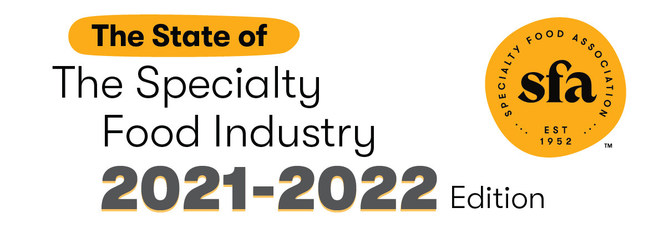NEW YORK, June 10, 2021 /PRNewswire/ — The Specialty Food Association (SFA) has released its annual State of the Specialty Food Industry Report, revealing that the specialty food market reached total sales of $170.4 billion in 2020, a 13 percent increase since 2018.
All food sales, both specialty and non, grew much faster between 2018 and 2020, a reflection of the COVID-19 pandemic’s effect on buying, at-home meal preparation, and consumption. Specialty food sales, specifically, grew 24 percent at retail from 2018-2020, and 19.4 percent in 2020 alone. Categories related to cooking or baking at home soared, benefitting products like baking mixes, pasta and sauces, frozen entrees, and meat, poultry, seafood (frozen, refrigerated).
In contrast to online and brick-and-mortar retail, sales to foodservice, which was devastated by the pandemic, fell off by 30 percent. Industry estimates predict foodservice’s overall recovery will take years, while retail sales are expected to continue thriving.
“The ripple across all channels of the specialty food industry has been tremendous,” said Bill Lynch, president of the SFA. “We’ve seen businesses flex their creativity in ways they never could have imagined, from restaurants becoming pop-up specialty food grocers to makers increasing production to meet consumer demand. Despite these historic challenges, the industry has continued to innovate and grow, as outlined in our annual research.”
The annual State of the Specialty Food Industry research is an examination of market size and sales; dollar and unit sales growth; specialty food category penetration; growth forecasts in key categories; and 10-year tracking and forecasting in key categories.
Key Facts and Figures:
Top 10 Categories in Retail Dollar Sales
- Meat, poultry, seafood (Frozen, refrigerated)
- Cheese and plant-based cheese
- Chips, pretzels, snacks
- Bread and baked goods
- Coffee and hot cocoa (non-RTD)
- Desserts (Frozen)
- Entrées (Refrigerated)
- Chocolate and other confectionery
- Entrées, lunch and dinner (Frozen)
- Condiments, dressings, marinades (Shelf stable)
Top 10 Fastest-Growing Categories
- Seasonings
- Sauces, pasta and pizza (Shelf stable)
- Beans, grains, rice – dry (Shelf stable)
- Fruit and vegetables (Frozen)
- Creams and creamers (Refrigerated)
- Plant-based meat alternatives (Refrigerated)
- Pasta (Refrigerated)
- Tea and coffee, RTD (Refrigerated)
- Tofu
- Creams and creamers (Shelf stable)
The Impact of COVID-19: Insights and Takeaways
- Center store rebirth. A year of home cooking has led to consumers rediscovering the usefulness and necessity of a home pantry.
- Improving discovery. Combined with limited in-store sampling, fewer demos, and the decimation of foodservice, 2020 was a rough year for innovation discovery. This will be one of the key issues for the specialty industry in 2021 and beyond.
- Specialty’s ecommerce visibility issue. Related to diminishing discovery, specialty is facing challenges with the growth of online shopping as it allows fewer opportunities for impulse buys.
- Plant-based competition. The plant-based specialty food and beverage market grew 42 percent, nearly twice as fast as the entire specialty market. Much of the growth occurred in 2020 when surge shopping served as a gateway in some categories. But the plant-based sector is shifting as big CPG players innovate in the specialty space, with massive funding and scale, and non-specialty ingredients.
- Channel shifting. Almost every online e-grocery market saw phenomenal growth in 2020, while drug stores gained new customers by adding grab-and-go and refrigerated aisles. Dollar stores continued pulling people from all other channels, and in 2021 are projected to account for 50 percent of all newly opened stores. Consumers shopped in stores for groceries that they may have rarely visited much in prior years.
The report will be discussed during a June 24 webinar, 1pm EST, free for SFA members/$19 for nonmembers, and will be a featured panel during Fancy Food Show 2021. Read more at specialtyfood.com/state2021
About the Specialty Food Association
The Specialty Food Association (SFA), is the leading trade association and source of information about the $170.4 billion specialty food industry. Founded in 1952 in New York City, the SFA represents makers, importers, retailers, distributors, and others in the trade. The SFA is known for its Fancy Food Shows; the sofi™ Awards, which honor excellence in specialty food and beverage; Trendspotter Panel Show reports and annual predictions; the State of the Specialty Food Industry Report; the Product Marketplace, featuring specialty foods and beverages in 161 categories and sub-categories; Infinite Aisle, a new ecommerce marketplace that enables SFA Members to make buyer-maker connections and sales year-round; Specialty Food LIVE!™, a digital marketplace event; and SFA Feed, the daily source for news, trends and new product information in the specialty food industry (feed.specialtyfood.com).
Facebook: Specialty Food Association
Twitter: @Specialty_Food
LinkedIn: Specialty Food Association
Instagram: @specialtyoodassociation
Hashtags: #ShapetheFutureofFood #SpecialtyFood
SOURCE Specialty Food Association
